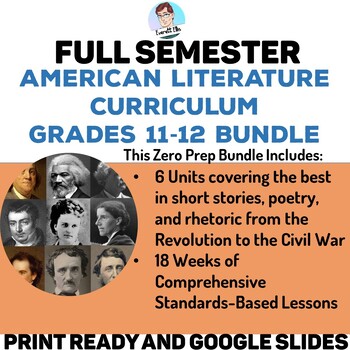ELA Full Semester American Literature Curriculum Grades 11-12 Bundle
- Zip
- Google Apps™

Products in this Bundle (17)
showing 1-5 of 17 products
Bonus
Also included in
- Set your students up for success with this zero prep, print and Google slides ready curriculum resource a full year of your American Literature course. In this resource you will find 13 units that span 36+ weeks of instruction:Rhetoric of the American RevolutionPost Revolution: American RomanticismPPrice $109.99Original Price $127.65Save $17.66
Description
Set your students up for success with this zero prep, print and Google slides ready curriculum resource an entire semester of your American Literature course. In this resource you will find 6 units that span 18 weeks of instruction:
- Rhetoric of the American Revolution
- Post Revolution: American Romanticism
- Prelude to the Civil War: American Transcendentalism
- The Dark Romanticism of Edgar Allan Poe
- The Anti-Slavery Rhetoric of Frederick Douglass
- Realism and Early Feminist Literature
Take a look at my FREE Q1 Roadmap and my FREE Q2 roadmap for a more in-depth look at these units.
This curriculum resource includes EVERY text your students will read. The approach to instruction is standards based and the texts have been selected as being the most representative of American Literature and Rhetoric from the Revolutionary period to the late 19th century.
Activities include:
- Daily bell ringer activities
- Pre-reading journals
- Embedded questions within printable texts
- Comprehension questions
- Lecture Notes
- Essay and group discussion prompts (with rubrics!)
- Multiple choice assessments
- Vocabulary (well over 100 new words are introduced and assessed throughout the bundle!)
- Character, theme, and figurative language charts
- Satire analyses
- and more!
Thorough answer keys and rubrics make you the expert in each of the following units.
In Unit 1, Rhetoric of the American Revolution, your students will:
- Study key concepts of rhetoric including ethos, pathos, and logos and rhetorical devices like antithesis, parallelism, and rhetorical questions.
- Examine the key concepts of 3 Revolutionary era texts from Thomas Paine, Patrick Henry and Ben Franklin.
- Engage in discussion and writing prompts that spur critical thinking.
In Unit 2, Post Revolution: American Romanticism, your students will:
- Learn about the origins of American literature and American myth making.
- Read 2 classic short stories from Washington Irving and 1 classic short story from Nathaniel Hawthorne.
- Examine how early American literature reflected on the past and predicted the future.
In Unit 3, Prelude to the Civil War: American Transcendentalism, your students will:
- Demonstrate quarterly proficiency on each of the RI, RL, and Writing standards that they have been working on all quarter.
- Learn the origins of American individualism from Emerson, protest from Thoreau, feminism from Fuller, and the anti-slavery movement from each of these important thinkers.
- Study the poetry of nature and the individual from Whitman, Emerson and Dickinson.
In Unit 4, The Dark Romanticism of Poe, your students will:
- Analyze Poe's contributions to American literature and Gothic horror through close readings of "The Cask of Amontillado" and "The Masque of the Red Death."
- Enhance their proficiency in making inferences (11-12.RL.1) and discussing theme (11-12.RL.2)
- Engage in discussion and writing prompts that spur critical thinking.
In Unit 5, The Anti-Slavery Rhetoric of Douglass, your students will:
- Study key concepts of rhetoric including ethos, pathos, and logos and rhetorical devices like antithesis, hypophora, and synecdoche.
- Engage in a close reading and rhetorical analysis of Douglass's most famous speech "What, to the Slave, is the Fourth of July?"
- Conduct their own research into Douglass's other speeches and draft an expository essay using primary and secondary sources.
In Unit 6, Realism and Early Feminist Literature, your students will:
- Demonstrate their end-of-semester proficiency Literature and Writing standards. All RL standards are covered through a study of five classic short stories.
- Learn the impact that Ambrose Bierce had on modern fiction, appreciate the lasting impact of Mark Twain's political satire, and examine the foundations of feminist literature in the works of Kate Chopin and Charlotte Perkins Gilman.
- At the conclusion of this unit, students will be more than prepared to understand the literary trends that evolve in 20th century American literature.
As a bonus I've included my MLA 9 Works Cited Page Notes and Worksheets lesson and my MLA 9 In-text citation notes and worksheets lesson which are essential for completing the Unit 5 research essay.
With every short story, poem and speech included in print-ready format, this resource will cover at least 18 weeks of lessons and possibly more! Craft the foundation for understanding American literary heritage with this full semester curriculum today!



